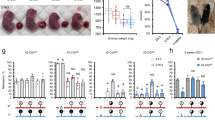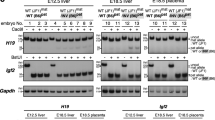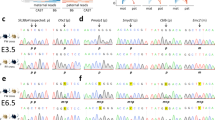Abstract
Genomic imprinting brings about allele-specific silencing according to parental origin1. Silencing is controlled by cis-acting regulatory regions that are differentially marked during gametogenesis and can act over hundreds of kilobases to silence many genes2,3,4,5,6. Two candidate imprinting control regions (ICRs) have been identified at the compact imprinted Gnas cluster on distal mouse chromosome 2, one at exon 1A upstream of Gnas itself7 and one covering the promoters for Gnasxl and the antisense Nespas (ref. 8). This imprinted cluster is complex, containing biallelic, maternally and paternally expressed transcripts that share exons9. Gnas itself is mainly biallelically expressed but is weakly paternally repressed in specific tissues10. Here we show that a paternally derived targeted deletion of the germline differentially methylated region at exon 1A abolishes tissue-specific imprinting of Gnas. This rescues the abnormal phenotype of mice with a maternally derived Gnas mutation11,12. Imprinting of alternative transcripts, Nesp, Gnasxl and Nespas (ref. 13), in the cluster is unaffected. The results establish that the differentially methylated region at exon 1A contains an imprinting control element that specifically regulates Gnas and comprises a characterized ICR for a gene that is only weakly imprinted in a minority of tissues. There must be a second ICR regulating the alternative transcripts.
This is a preview of subscription content, access via your institution
Access options
Subscribe to this journal
Receive 12 print issues and online access
$209.00 per year
only $17.42 per issue
Buy this article
- Purchase on Springer Link
- Instant access to full article PDF
Prices may be subject to local taxes which are calculated during checkout




Similar content being viewed by others
References
Cattanach, B.M. & Kirk, M. Differential activity of maternally and paternally derived chromosome regions in mice. Nature 315, 496–498 (1985).
Leighton, P.A., Ingram, R.S., Eggenschwiler, J., Efstratiadis, A. & Tilghman, S.M. Disruption of imprinting caused by deletion of the H19 gene region in mice. Nature 375, 34–39 (1995).
Nicholls, R.D. & Knepper, J.L. Genome organisation, function and imprinting in Prader-Willi and Angelman syndromes. Ann. Rev. Genomics Hum. Genet. 2, 153–175 (2001).
Zwart, R., Sleutels, F., Wutz, A., Schinkel, A.H. & Barlow, D.P. Bidirectional action of the Igf2r imprint control element on upstream and downstream imprinted genes. Genes Dev. 15, 2361–2366 (2001).
Fitzpatrick, G.V., Soloway, P.D. & Higgins, M.J. Regional loss of imprinting and growth deficiency in mice with a targeted deletion of KvDMR1. Nat. Genet. 32, 426–431 (2002).
Lin, S.-P. et al. Asymmetric regulation of imprinting on the maternal and paternal chromosomes at the Dlk1-Gtl2 imprinted cluster on mouse chromosome 12. Nat. Genet. 35, 97–102 (2003).
Liu, J., Yu, S., Litman, D., Chen, W. & Weinstein, L.S. Identification of a methylation imprint mark within the mouse Gnas locus. Mol. Cell. Biol. 20, 5808–5817 (2000).
Coombes, C. et al. Epigenetic properties and identification of an imprint mark in the Nesp-Gnasxl domain of the mouse Gnas imprinted locus. Mol. Cell. Biol. 23, 5475–5488 (2003).
Peters, J. et al. A cluster of oppositely imprinted transcripts at the Gnas locus in the distal imprinting region of mouse chromosome 2. Proc. Natl. Acad. Sci. USA 96, 3830–3835 (1999).
Yu, S. et al. Variable and tissue-specific hormone resistance in heterotrimeric Gs protein α-subunit (Gsα) knockout mice is due to tissue-specific imprinting of the Gsα gene. Proc. Natl. Acad. Sci. USA 95, 8715–8720 (1998).
Cattanach, B.M., Peters, J., Ball, S. & Rasberry, C. Two imprinted gene mutations: three phenotypes. Hum. Mol. Genet. 9, 2263–2273 (2000).
Skinner, J.A., Cattanach, B.M. & Peters, J. The imprinted oedematous-small mutation on mouse chromosome 2 identifies new roles for Gnas and Gnasxl in development. Genomics 80, 373–375 (2002).
Wroe, S.F. et al. An imprinted transcript, antisense to Nesp, adds complexity to the cluster of imprinted genes at the mouse Gnas locus. Proc. Natl. Acad. Sci. USA 97, 3342–3346 (2000).
Li, T. et al. Tissue-specific expression of antisense and sense transcripts at the imprinted Gnas locus. Genomics 69, 295–304 (2000).
Chan, S.D.H. et al. Cloning and characterisation of the mouse Gsα promoter: activation by retinoic acid in F9 teratocarcinoma cells. Endocrine J. 2, 311–316 (1994).
Weinstein, L.S., Yu, S., Warner, D.R. & Liu, J. Endocrine manifestations of stimulatory G protein α-subunit mutations and the role of genomic imprinting. Endocrine Rev. 22, 675–705 (2001).
Liu, J. et al. A GNAS1 imprinting defect in pseudohypoparathyroidism type IB. J. Clin. Invest. 106, 1167–1174 (2000).
Bastepe, M., Lane, A.H. & Juppner, H. Paternal uniparental isodisomy of chromosome 20q - and the resulting changes in GNAS1 methylation - as a plausible cause of pseudohypoparathyroidism. Am. J. Hum. Genet. 68, 1283–1289 (2001).
Bastepe, M. et al. Autosomal dominant pseudohypoparathyroidism type Ib is associated with a heterozygous microdeletion that likely disrupts a putative imprinting control element of GNAS. J. Clin. Invest. 112, 1255–1263 (2003).
Spahn, L. & Barlow, D.P. An ICE pattern crystallizes. Nat. Genet. 35, 11–12 (2003).
Ischia, R. et al. Molecular cloning and characterisation of NESP55, a novel chromogranin-like precursor of a peptide with 5-HT1B receptor antagonist activity. J. Biol. Chem. 17, 11657–11662 (1997).
Kehlenbach, R.H., Matthey, J. & Huttner, W.B. XL alpha s is a new type of G protein. Nature 372, 804–808 (1994).
Hayward, B.E. et al. The human GNAS1 gene is imprinted and encodes distinct paternally and biallelically expressed G proteins. Proc. Natl. Acad. Sci. USA 95, 10038–10043 (1998).
Hayward, B.E., Moran, V., Strain, L. & Bonthron, D.T. Bidirectional imprinting of a single gene: GNAS1 encodes maternally, paternally, and biallelically derived proteins. Proc. Natl. Acad. Sci. USA 95, 15475–15480 (1998).
Hayward, B.E. & Bonthron, D.T. An imprinted antisense transcript at the human GNAS1 locus. Hum. Mol. Genet. 9, 835–841 (2000).
Storck, T., Krüth, U., Kolhekar, R., Sprengel, R. & Seeburg, P.H. Rapid construction in yeast of complex targeting vectors for gene manipulation in the mouse. Nucleic Acids Res. 24, 4594–4596 (1996).
Bunting, M., Bernstein, K.E., Greer, J.M., Capecchi, M.R. & Thomas, K.R. Targeting genes for self-excision in the germline. Genes Dev. 13, 1524–1528 (1999).
Ramirez-Solis, R., Davis, A.C. & Bradley, A. Gene targeting in embryonic stem cells. Methods Enzymol. 225, 855–878 (1993).
Hough, T. et al. Novel phenotypes identified by plasma biochemical screen in the mouse. Mamm. Genome 13, 595–602 (2002).
Acknowledgements
We thank B.M. Cattanach and G. Kelsey for useful comments on the manuscript; P. Denny for advice and help in obtaining the sequence of the chromosome 2 mouse BAC clone RP23-439H2 from the UK Mouse Genome Sequencing Programme; J. Bowler for injection of blastocysts; the Harwell Transgenic Facility for technical support for the targeting; M. Harrison, L. Jones and J. McNaughton for animal husbandry; and A. Ford's group for Imaging Services. Other sequencing was carried out by the GEMS core at MRC Harwell.
Author information
Authors and Affiliations
Corresponding author
Ethics declarations
Competing interests
The authors declare no competing financial interests.
Rights and permissions
About this article
Cite this article
Williamson, C., Ball, S., Nottingham, W. et al. A cis-acting control region is required exclusively for the tissue-specific imprinting of Gnas. Nat Genet 36, 894–899 (2004). https://doi.org/10.1038/ng1398
Received:
Accepted:
Published:
Issue Date:
DOI: https://doi.org/10.1038/ng1398
This article is cited by
-
A novel long-range deletion spanning STX16 and NPEPL1 causing imprinting defects of the GNAS locus discovered in a patient with autosomal-dominant pseudohypoparathyroidism type 1B
Endocrine (2020)
-
Mosaicism for GNAS methylation defects associated with pseudohypoparathyroidism type 1B arose in early post-zygotic phases
Clinical Epigenetics (2018)
-
A multi-dimensional characterization of anxiety in monozygotic twin pairs reveals susceptibility loci in humans
Translational Psychiatry (2017)
-
Pseudohypoparathyroidism and Gsα–cAMP-linked disorders: current view and open issues
Nature Reviews Endocrinology (2016)
-
GNAS Spectrum of Disorders
Current Osteoporosis Reports (2015)



